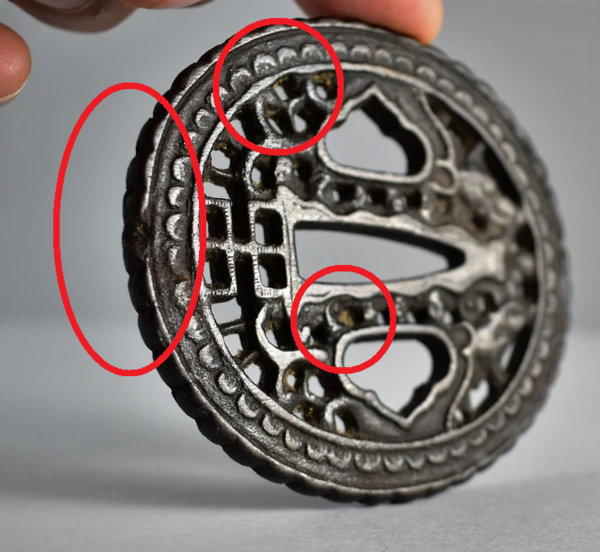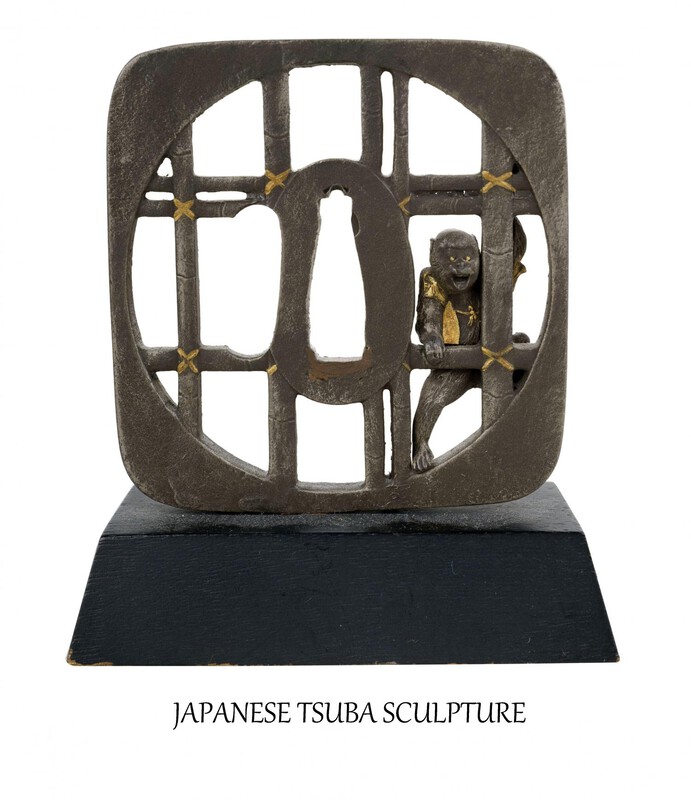-
Posts
3,592 -
Joined
-
Last visited
-
Days Won
97
Content Type
Profiles
Forums
Events
Store
Downloads
Gallery
Everything posted by Spartancrest
-
I just found a fantastic Shishi tsuba going to auction - https://www.jauce.com/auction/1040944781 The same design is found in the Chōsen Gafu book [p.56] - I can't work out if the Ura view is a Shishi emerging from waves or clouds? I do think the placement of the design on the guard is better than on the drawing. It simply meant changing the hitsu.
-
These three turned up on Worthpoint and another from a recent auction. I have noticed the 'seal' or Kao can vary amongst examples, this may have indicated specific makers who all signed the same way? As a side question we all know what a Daisho is, but what is the name for three guards in the same 'set' Tanto, Wak and Katana size? You could also include a Nō-dachi [or if you prefer Ōdachi] making it four of a kind?
-
Yes sorry Marc, the two images are from a little book I have just released on the Rijksmuseum in Amsterdam. It is not a technical book by any means. More of a visual catalog / catalogue
-
https://collection.maas.museum/object/199136 From Wikipedia "In 1883, Tenison-Woods was invited by his friend and governor of Singapore, Sir Frederick Weld, to undertake a scientific tour in the Straits Settlements. Tenison-Woods also travelled extensively in Java, the adjacent islands and the Philippines, and provided the British government with a valuable confidential report on the coal resources of the East. He also travelled to China and Japan, returning to Sydney in 1886." He donated an eclectic collection of small Japanese and other Asian artifacts most with the same time provenance, but only the one tsuba. https://collection.maas.museum/search?q=Reverend Julian Tenison-Woods So it would appear Rev. Woods acquired the guard in Japan itself probably as a souvenir perhaps? He died at the relatively young age of 56. So we are stuck again by not knowing just how old the tsuba was when he picked it up - but we know it was made prior to 1886.
-
-
I am surprised no one else has replied to this thread - I came across a 'recipe' if you like, of how, supposedly, Kinai was able to patinate their iron guards. Though the exact manner of how it was managed is elusive. CATALOGUE OF SPECIMENS OF Japanese LACQUER & METAL WORK. EXHIBITED IN 1894 Part II. THE FURNITURE OF THE SWORD. [Note : This extract is pertaining specifically to Iron tsuba] A few words concerning the iron so often employed for tsuba (and indeed for other accessories of the sword, and for many ornamental and useful objects) may here be introduced. As no analyses of this metal were available at the time, the writer asked an expert metallurgical chemist, Mr. Arnold Philip, then (1889) of the Royal Engineering College, Cooper's Hill, to examine chemically three typical guards. Mr. Thomas Turner, of the Mason College, Birmingham, was so good as to determine their degree of hardness. The percentage results, with estimations of specific gravity, are given in this table: To these processes must be added the various methods in use by Japanese craftsmen to produce surface colorations and effects upon metals. These have been already described. One such process has however not been recorded hitherto, namely that by which a lustrous black coating of the magnetic oxide of iron was formed. This was produced by heating the iron object with a limited supply of air in the presence of water-vapour and of the products of the imperfect combustion of vegetable matter. The dark and glossy patina thus produced has generally resisted the destructive influence of moisture, so that after the lapse of a century or more the surface remains intact, as in many of the guards made by Kinai of Echizen. A. H. CHURCH.
-
I was tossing up [no pun intended] posting this on "What is represented on this tsuba??" or "Well that's different..." or even "Monkeying Around" - the thought of putting it in "Looking for crab sukashi tsuba pictures" never entered my head. But I will stick with 'artwork' https://www.jauce.com/auction/c1039646759 It is not a genre that my wife would let me hang on the wall! I don't know what all the Kanji means on the first one [both sides] , maybe an instruction manual? Maybe "Shudder at Shunga" would have worked better? [I will not be offended if this post gets pulled (once again no pun intended)]
-
Just to pipe in on the likelihood of that last tsuba being cast - there is no doubt about it. That particular design is perhaps the most common cast namban ever produced. [Not the most common cast tsuba - that honor goes to another dragon - produced over the last 70 years - https://www.ebay.com.au/itm/363337087054 ] There are some shockers out there with voids, over-runs and seams - a style to be viewed with very much caution. https://www.etsy.com/au/listing/758579575/antique-nanban-tsuba This one is of superior make, the seppa-dai is different but still little let downs. One here very poor, with voids. As you can see - common - they all tend to have the same 'Yamagata' - hitsu-ana shape. This one is the real clincher - how it avoided the re-melt bin I will never know! It is currently listed at a discount at only $80 - expensive scrap metal price if you ask me!
-
It is interesting to see that the designs are all very similar but the overall outline shapes do vary.
-
Stephen I just found a file with some of the Jakushi dragons - one being yours. Eight examples all told. The files are big so I will send one at a time as composites of four each.
-
I think a lot of handling and rubbing with a soft cotton rag [or putting it in your pocket for an extended period will get the dark patina back- called tsuba fussing!] I doubt you could get a colour match to the inlay and it would no doubt be expensive - I personally think it looks age appropriate and shouldn't be tampered with. There are some links here and other threads can be found with NMB searches. Welcome to the world of tsuba.
-
From what I understand 'original' tachi tsuba had no hitsu-ana as the koshirae did not involve kogai or kozuka. However this statement does not take in the fact that many tachi tsuba were altered to be used on katana or wakizashi. Often this has also meant the nakago-ana has also been altered to orient the guard [with a pattern or scene] in the correct viewing direction when remounted.
-
The tsuba is Heianjo style with asanoha or 'hemp' pattern decoration with the addition of five pointed 'stars' or more likely 'apricot blossoms' ? [Signaling the arrival of Spring.] The guard is genuine, perhaps the 'flowers' added later?
-
Chris, I think Stephen King [Steves87] has lots of images of the Jakushi dragon like yours - hope he comes in on the thread. The waterfall kaku-maru-gata is Shoami [Kanenori?], not sure who exactly, looks like only a part signature. Very good starter set for sure. [I can't say my first six were as good! ]
-
Wow that looks even higher from the side, nicely edged seppa as well- plenty of spare parts! You need to get that stone seen by a jeweller, it might be an Emerald or just Tourmaline.
-
I love the second guard- I suppose it is possible to dismount it from the clasp?
-
-
Top quality one in the Metropolitan Museum of Art. 29.100.972 76 mm x 73 mm x 5 mm Wt. 138.9 g Shakudo, gold and copper. Like the very first example in the first post. [from the Michael Tomkinson collection (no.82)]. It has Kanmuri (冠) (3). The cap worn by Shinto clergy and courtiers in Japan.
-
"Wealth implied by its absence" - is how I have been told the theme of rats amongst the rice can be viewed. No obvious signs of prosperity but the rats imply an abundance of food, enough to have 'pests'. If you were poor = no rice and no rats either!
-
Yves, I am still looking for some rats/mice like your design - no sign yet but if I mention the word 'unique' they would come out of the woodwork. I will continue to look but your piece is 'not common' by any means. [I rather like tsuba with rodents myself!]
-
More than a century of debate has moved us no closer to the answer. Taken from "Japan and it's Art" by Marcus B. Huish 1889 "The decoration of the sword furniture showed symptoms of decline early in the present century [19th]. Working in hard wrought iron was first of all shirked, and similar effects were endeavoured to be produced by castings; then the decoration ran riot and transgressed all limits, so that many of the pieces made between 1840-1870 could never have been used for the purposes for which they were professedly intended; such products are remarkable in a way, as showing the lengths to which elaboration may be carried, but they can never stand for a day beside the dignified workmanship of an earlier date. Imitations of sword guards are now being imported into the market. These are cast from old specimens, and can usually be detected by holding them at the point of one's finger and hitting them sharply with another piece of metal, when they will emit a dull sound only, whereas a fine old guard will ring like the best bell-metal. It is well to test all guards in this way, but it must be recollected that guards with much piercing will not ring, and that many of those made since the beginning of this century are of such malleable iron as not to stand the test. It is a question which has not yet been solved whether some of the old guards may not be castings, even some of those which are chased. The difference between wrought and cast iron is that the latter contains from 1 1/2 to 4 percent, of carbon, the former hardly any; but it is possible to anneal or toughen cast iron by a process known as 'Cementation' [Ed. In metallurgy: a process of altering a metal by heating it in contact with a powdered solid], that is, by a surface removal of carbon. Many of the guards are covered with oxide of iron, to which they owe much of their beauty." This does push the casting dates back before 1840 so Edo or not? What I did find strange is the 'ringing test' which is refuted almost immediately by himself so why even propagate it? It is still cited by many as a true test of whether a guard is cast or not - yet it does not work in practice and is very subjective.
-
Soren please don't use my own books against me - You could have used the front cover, that book needs all the publicity it can get!
-
Hi Roger - just speculation but it looks recently 'cleaned'. Too aggressively at that- looks like half was done with steel wool? Lucky they didn't get into the nunome.
-
Coincidence, one with horses is listed for auction. No silver though. https://www.jauce.com/auction/l1037860408



























